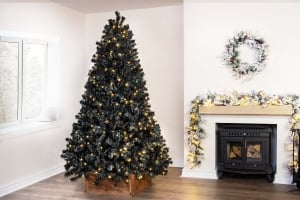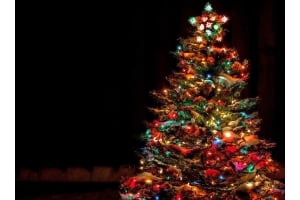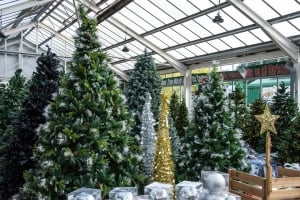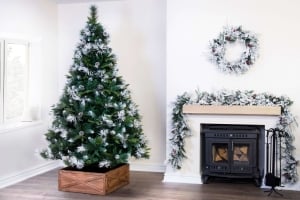Why Do We Have Christmas Trees?
For decades, many of us have decorated our artificial Christmas trees with baubles, twinkling lights, and beautiful decorations, passing the practice down through generations.
While the Christmas tree is perhaps the most well-known, Christmas wouldn't be traditional without wreaths, holly, mistletoe, and, most importantly, the Christmas tree.
However, what is the purpose of Christmas trees and where did this tradition begin?
What is the origin of the Christmas tree tradition?
The history of Christmas trees dates back to Ancient Egypt and Rome's symbolic use of evergreen trees and continuing today with the German tradition of candle-lit Christmas trees, which has evolved into Christmas tree lights. Long before Christianity, trees and plants that stayed green throughout the year had a unique significance for people throughout the winter.
Just as modern people adorn their houses with pines, spruce, and fir trees during the Christmas season, ancient folk placed evergreen boughs over their doorways and windows. In many countries, evergreen plants and trees were considered to ward off witches, ghosts, evil spirits, and disease.
Germany was credited with establishing modern Christmas tree traditions in the sixteenth century when pious Christians began bringing decorated trees into their houses. Others constructed Christmas pyramids of wood and decorated them with evergreens and candles if the wood was in short supply.
A classic medieval tale about Adam and Eve had a "paradise tree”, a fir tree draped with apples that portrayed the Garden of Eden. On 24th December (Christmas Eve), the Catholic feast day of Adam and Eve, Germans placed a paradise tree in their houses.
Who was the first person to bring a Christmas tree into their home?
Martin Luther, a 16th-century German preacher, may have been the first to introduce a Christmas tree into a home in the manner we know it today. According to legend, while drafting a sermon one winter evening on Christmas Eve, he was taken aback by the beauty of stars glittering among evergreens.
It was so attractive that he returned home and explained to his family that it reminded him of Jesus, who left the heavens to come to earth at Christmas. As a result, he brought a tree inside his home and decorated it with candles to symbolise the stars.
When was the first Christmas tree brought to the UK?
In 1848, the Illustrated London News depicted Queen Victoria and her German Prince, Albert, standing around a Christmas tree with their children. Unlike the previous royal family, Victoria was very popular with her people, and what occurred at court became quickly fashionable in Britain.
However, Queen Victoria and Prince Albert were not responsible for bringing the Christmas tree to the UK. So, where did the Christmas tree come from?
In the 1790s, Queen Charlotte, the German wife of George III, introduced the notion of the Christmas tree to England in accordance with her cultural Christmas traditions.
Instead, the Christmas trees were small plants that could be put on tables but still had sparkling lights and ornaments, similar to the small Christmas trees we use today.
How have Christmas trees changed nowadays?
Christmas trees are the focal point of the festive season. However, they are also at the centre of a traditional Christmas debate: is it preferable to have a real or an artificial Christmas tree?
Some families brave the bitter cold to select a short-lived evergreen straight from the fields. Meanwhile, a growing number of people go to their local shop or get their artificial Christmas tree online with the press of a button.
Because the habit of cutting real Christmas trees had severely reduced the region's evergreen woods, the first artificial Christmas trees were created in Germany in the 1800s. Originally, Germans made artificial trees out of goose feathers.
Nowadays, the commercial success of the artificial Christmas tree has shifted dramatically. From traditional Christmas trees to black Christmas trees, there’s something for every style. Christmas can be all about cheerful bright colours such as magenta and blue or classic and modern hues like green and gold.
Why do we decorate Christmas trees?
Bringing evergreen trees inside has been used to commemorate winter celebrations for thousands of years.
Apart from the established candle aesthetic in Europe, handcrafted Christmas tree decorations, including ornaments, garlands, and sweets, gained significant popularity in the late 1800s.
Why we decorate Christmas trees varies according to culture. Christmas decorations include Christmas tree lights, colourful Christmas baubles, glass decorations, and paper flowers.
The Yule tree
The tradition of keeping a Christmas tree is said to have Pagan mythology roots. Pagans are said to have decorated a Yule tree, which was often left alone to flourish.
People used to hang what they believed to be sacred gifts to deities such as Dionysus and Attis on the Yule tree. This tradition may have been the precursor of modern-day Christmas gift-giving.
Secular traditions
Following the 1917 revolution, the Bolsheviks outlawed Christmas in 1929 as part of their government policy of atheism. The Christmas tree and associated festivities were progressively phased out. When individuals wanted to celebrate Christmas, they did so secretly.
Many Christmas customs were reintroduced in 1935 as a new secular New Year's celebration. Among them were decorating a tree, the festive decorating of the home and family gatherings, and the gift-giving visit.
Podłaźniczka
Podłaźniczka is a traditional Christmas ornament in Poland and Slovakia. It was often constructed from the upside-down top of a fir tree, adorned with tissue paper, sweets, apples, nuts, traditional Polish themes, or straw. This ornament was then hung over or in the corner of the Vigil table.
It was intended to bring the household good fortune and wealth. This practice ceased to exist in the early seventeenth century.
Germanic traditions
In Estonia, Latvia, and Germany, trees were set in guildhalls and adorned with sweets and ornaments for the enjoyment of apprentice children on Christmas Day. This custom stretches back to 1441. Modern Christmas tree customs are said to have origins in Germanic traditions from this era.
Protestantism
The first Christmas tree was discovered in 1576 on the keystone sculpture of private property in Alsace. German Protestants are sometimes credited with inventing the Christmas tree, which they used to adorn their homes.
North America
Before 1781, there was no custom of a decorated Christmas tree in North America. General Friedrich Adolf Riedesel and his wife brought the practice to North America in the winter of 1781. They hosted a Christmas celebration in Sorel, Quebec, dazzling their guests with a fir tree decked with candles and fruit.
FAQs about Christmas trees
Is a Christmas tree a religious symbol?
Numerous ancient societies regarded evergreens as a symbol of production and Christmas trees traditionally had religious connotations. However, today they’re not considered by all societies to be religious symbols. Instead, they are a symbol of celebration.
Why do we put gifts under the Christmas tree?
The tradition of placing presents beneath a Christmas tree may have begun with St. Nicholas, a bishop well-known for his generosity towards impoverished children. His feast day is on 6th December, just before the annual Christmas holiday.
Who is said to have first put candles on a Christmas tree?
The tradition of attaching glowy lights to Christmas tree branches is most often linked to Martin Luther, the leader of the Protestant Reformation in the 1500s. Today we use glittering LED lights instead of candles.
Browse our fantastic Christmas trees and decorations
The Christmas tree is a staple of festive gatherings around the world. Nowadays, having a Christmas tree in your home is considered a form of celebration, often including a gathering, decorating, and finally displaying gifts to be unwrapped on Christmas morning.
Nothing beats a beautifully decorated Christmas tree with glittering lights and colourful ornaments to make you feel cheerful. Decorating your tree is just as essential as picking the perfect Christmas tree for your home!
Christmas Tree World offers an amazing selection of Christmas decorations and artificial Christmas trees to meet your design aesthetic. These include fibre optic Christmas trees to enchant you and your family, 20 foot artificial Christmas trees to amaze your guests, and mini Christmas trees to help you feel festive in more compact spaces. Shop your favourites today!






